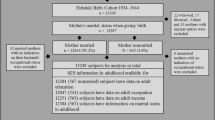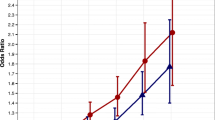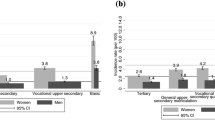Abstract
Although it is known that schizophrenia is associated with social class, controversy exists as to the nature of this association. The authors studied the incidence of schizophrenia in relation to social class at birth in a population-based cohort of 88,829 offspring born in Jerusalem in 1964–1976. They constructed a six-point scale to index social class, based on paternal occupation at the time of birth, with each of 108 occupations being ranked by mean education. Cox proportional hazards methods were used in adjusting for sex, parents’ ages, duration of marriage and birth order. Linkage with Israel’s Psychiatric Registry identified 637 people admitted to psychiatric care facilities with schizophrenia-related diagnoses, before 1998. There was no gradient of risk for schizophrenia associated with social class at birth; however, offspring of fathers in the lowest social class showed a modest increase in risk (adjusted Relative Risk = 1.4; 95% Confidence interval = 1.1–1.8, P = 0.002). These data suggest that in contrast to many other health outcomes, there is not a continuous gradient for increasing schizophrenia with decreasing social class of origin. Instead, a modest increase in risk for schizophrenia was observed only for those born at the bottom of the social ladder.
Similar content being viewed by others
References
Adelstein AM (1980) Life-style in occupational cancer. J Toxicol Environ Health 6:953–962
Adler NE, Boyce T, Chesney MA et al (1994) Socioeconomic status and health: the challenge of the gradient. Am Psychol 49:15–24
Brown AS, Cohen P, Harkavy-Friedman J et al (2001) A.E. Bennett research award. Prenatal rubella, premorbid abnormalities, and adult schizophrenia. Biol Psychiatry 49:473–486
Brown AS, Begg MD, Gravenstein S et al (2004) Serologic evidence of prenatal influenza in the etiology of schizophrenia. Arch Gen Psychiatry 61:774–780
Byrne M, Agerbo E, Eaton WW et al (2004) Parental socio-economic status and risk of first admission with schizophrenia- a Danish national register based study. Soc Psychiatry Psychiatr Epidemiol 39:87–96
Castle DJ, Scott K, Wessely S et al (1993) Does social deprivation during gestation and early life predispose to later schizophrenia? Soc Psychiatry Psychiatr Epidemiol 28:1–4
Corcoran C, Perrin M, Harlap S et al (2008) Incidence of schizophrenia among second-generation immigrants in the Jerusalem perinatal cohort. Schizophr Bull [Epub ahead of print]
Davies AM, Prywes R, Tzur B et al (1969) The Jerusalem Perinatal Study. 1. Design and organization of a continuing, community-based, record-linked survey. Isr J Med Sci 5:1095–1106
Dohrenwend BP, Levav I, Shrout PE et al (1992) Socioeconomic status and psychiatric disorders: the causation-selection issue. Science 255:946–952
Eaton WW (1985) Epidemiology of schizophrenia. Epidemiol Rev 7:105–126
Galobardes B, Davey Smith G, Jeffreys M et al (2006) Childhood socioeconomic circumstances predict specific causes of death in adulthood: the Glasgow student cohort study. J Epidemiol Community Health 60:527–529
Goldberg EM, Morrison SL (1963) Schizophrenia and social class. Br J Psychiatry 109:785–802
Hare EH, Price JS, Slater E (1972) Parenthal social class in psychiatric patients. Br J Psychiatry 121:515–534
Harlap S, Davies AM, Grover NB et al (1977) The Jerusalem Perinatal Study: the first decade 1964–73. Isr J Med Sci 13:1073–1091
Harlap S, Davies AM, Deutsch L et al (2007) The Jerusalem Perinatal Study cohort, 1964–2005: methods and a review of the main results. Paediatr Perinat Epidemiol (in press)
Harrison G (2004) Trajectories of psychosis: towards a new social biology of schizophrenia. Epidemiol Psichiatr Soc 13:152–157
Hollingshead AB, Redlich FC (1958) Social class and mental illness: a community study. Wiley, New York
Jarvis E (1971) Insanity and idiocy in Massachusetts: report of the Commission on Lunacy (1855). Harvard University Press, Cambridge
Jones P, Rodgers B, Murray R et al (1994) Child development risk factors for adult schizophrenia in the British 1946 birth cohort. Lancet 344:1398–1402
Koenig JI, Kirkpatrick B, Lee P (2002) Glucocorticoid hormones and early brain development in schizophrenia. Neuropsychopharmacology 27:309–318
Kraus V (1981) Perception of the occupational structures in Israel. Megamot 26:283–294
Kraus JF, Borhani NO, Franti CE (1980) Socioeconomic status, ethnicity, and risk of coronary heart disease. Am J Epidemiol 111:407–414
Makikyro T, Isohanni M, Moring J et al (1997) Is a child’s risk of early onset schizophrenia increased in the highest social class? Schizophr Res 23:245–252
Malaspina D, Harlap S, Fennig S et al (2001) Advancing paternal age and the risk of schizophrenia. Arch Gen Psychiatry 58:361–367
Marmot MG (2003) Understanding social inequalities in health. Perspect Biol Med 46:S9–S23
Marmot MG, Kogevinas M, Elston MA (1991) Socioeconomic status and disease. WHO Reg Publ Eur Ser 37:113–146
Mulvany F, O’Callaghan E, Takei N et al (2001) Effect of social class at birth on risk and presentation of schizophrenia: case-control study. BMJ 323:1398–1401
Opler MG, Brown AS, Graziano J et al (2004) Prenatal lead exposure, delta-aminolevulinic acid, and schizophrenia. Environ Health Perspect 112:548–552
SAS [computer program] (2004) Version 9.0. SAS Institute Inc, Cary
Smith GD, Egger M (1992) Socioeconomic differences in mortality in Britain and the United States. Am J Public Health 82:1079–1081
Smith GD, Hart C, Blane D et al (1997) Lifetime socioeconomic position and mortality: prospective observational study. BMJ 314:547–552
Susser M, Watson W, Hopper K (1985) Sociology in medicine. Oxford University Press, Oxford
Susser E, Neugebauer R, Hoek HW et al (1996) Schizophrenia after prenatal famine: further evidence. Arch Gen Psychiatry 53:25–31
Susser E, Schwartz S, Morabia A (2006) **et al. Psychiatric epidemiology: searching for the causes of mental disorders. Oxford University Press, New York
Thirthalli J, Benegal V (2006) Psychosis among substance users. Curr Opin Psychiatry 19:239–245
Timms D (1998) Gender, social mobility and psychiatric diagnoses. Soc Sci Med 46:1235–1247
Weiser M, Reichenberg A, Grotto I et al (2004) Higher rates of cigarette smoking in male adolescents before the onset of schizophrenia: a historical-Prospective Cohort Study. Am J Psychiatry 161:1219–1223
Weiser M, Kanyas K, Malaspina D et al (2005) Sensitivity of ICD-10 diagnosis of psychotic disorders in the Israeli National Hospitalization Registry compared with RDC diagnoses based on SADS-L. Compr Psychiatry 46:38–42
Wicks S, Hjern A, Gunnell D et al (2005) Social adversity in childhood and the risk of developing psychosis: a national cohort study. Am J Psychiatry 162:1652–1657
Wiersma D, Giel R, De Jong A et al (1983) Social class and schizophrenia in a Dutch cohort. Psychol Med 13:141–150
Acknowledgments
Supported by the National Institutes of Health, 1R01 MH059114-05 (DM); 2K24 MH01699 (DM) and K23MH066279 (CC) and 2R01 CA080197 (SH) and NARSAD (DM, SH, CC). We thank the mothers, fathers and offspring who are in the Jerusalem Perinatal Study. We also thank Dr. Y Friedlander.
Author information
Authors and Affiliations
Corresponding author
Rights and permissions
About this article
Cite this article
Corcoran, C., Perrin, M., Harlap, S. et al. Effect of socioeconomic status and parents’ education at birth on risk of schizophrenia in offspring. Soc Psychiat Epidemiol 44, 265–271 (2009). https://doi.org/10.1007/s00127-008-0439-5
Received:
Revised:
Published:
Issue Date:
DOI: https://doi.org/10.1007/s00127-008-0439-5




